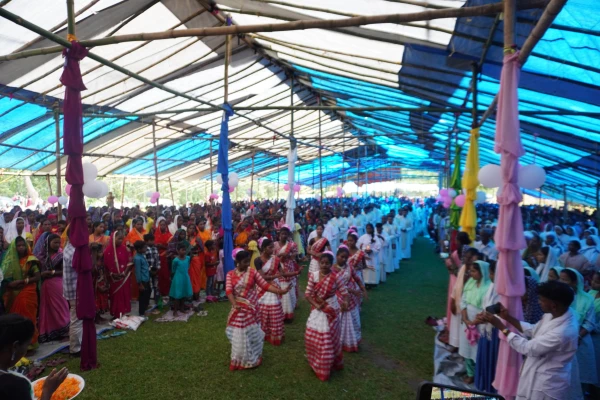Bangalore, India, Sep 10, 2024 / 11:15 am
More than 4,000 Catholics on Sept. 2 assembled in the remote Jamboni jungle to mark the 25-year observance of the death of 33-year-old Father Arul Das of the Balasore Diocese, who was shot and pierced with arrows in his thatched chapel-house during the early hours of Sept. 2, 1999.
“Father Arul very closely followed the life of Jesus. Like Jesus as a good shepherd, Father Arul too tried to be a good shepherd for the people of this locality,” said Balasore Bishop Varghese Thottamkara in his sermon at the jubilee Mass.
Along with the bishop, over 50 priests and hundreds of nuns from different parts of the sprawling diocese and beyond were present at the celebration at which the clergyman was hailed as a martyr.

“Father Arul was a priest of Christ. He came to serve the faithful of Balasore, especially of the Ho tribe people,” Thottamkara said.
“Through his life-giving witness he gives the best example for us. The blood of the martyrs is the seed of the Church,” the prelate added.
“While only 18 Ho families had embraced Christian faith in Jamboni at the death of Father Arul in 1999, the number has swelled to over 400 in Jamboni mission area now,” Father Varghese Puthumattam, who has compiled the biography of the missionary, told CNA.
Arul became involved with the Ho tribals in the jungle region when he was assigned as a deacon for pastoral duty at the challenging mission. Even a quarter-century later, the outpost lacks electricity and proper roads.
After his ordination in 1993, he was posted in the area and went to neighboring Jharkhand to learn the Ho language. The priest launched full-fledged work among the tribe, walking through the jungles without motorable roads to reach out to locals, many of them illiterate.
“We had to carry even bicycles on the shoulders to cross rocky and slushy terrains and streams,” Puthumattam remembered, recounting the challenging mission work undertaken with Arul.
While camping in his hut church at the remote Jamboni village, Arul was killed by a gang led by Hindu fundamentalist Dara Singh when the latter was on the run after having committed a triple murder in January 1999.
“Christian faith has taken deep roots among our people because of the martyrdom of Father Arul,” Durga Singh Godsara told CNA. Godsara is a catechist and was one of the first converts that Arul helped lead to the Church.
After Arul was killed, Godsara recounted what one of his fellow converts told him: “I will give up as it is dangerous and they would kill us too.”
“But I told him we have to die for the faith our guru [master] has taught us. Later I prayed with him; he got healed and he went to live 20 more years,” Godsara said.
“Our people have deep faith in the healing power of Father Arul that they bring the sick to this spot and get instant healing,” he added.
“We routinely hear ‘the blood of the martyrs is the seed of the Church.’ It has been literally fulfilled in Jamboni,” Sister Elizabeth Rani told CNA.
(Story continues below)
“I came here for the first anniversary in 2000. What an amazing development has taken place over the years with the thousands of Ho people embracing the Christian faith,” said Rani, who belongs to the Congregation of St Anne.
“‘Arul’ in our language [Tamil] means ‘blessing,’ and I am happy — he has indeed become a blessing to the Ho tribals,” the nun added.
“Our people were enthusiastic about the historic occasion,” Father Francis Xavier Singh, vicar of Holy Rosary Parish of Bagdapha that comprises the Jamboni area, told CNA.
“They worked voluntarily through the night to prepare the lunch for more than 4,000 people,” he added.
Thottamkara told CNA that there “is indeed a growing popular devotion to Father Arul.” The bishop noted that several miraculous healings have been reported by the Ho tribe.
“The diocese will set up committees to document and scrutinize these to decide how to take these up further,” Thottamkara said.






